Clinical Example: Nail Contour Correction After Eponychial Tumor Excision
|
Nail deformities may result from growths changing the
contour of the germinal matrix. These may appear
permanent, but normal nail plate contour can be restored
if the mass effect is corrected without damaging the
germinal matrix. These five cases demonstrate the
recovery potential of the nail bed in this circumstance. |
| Click on each image for a larger picture |
| Case 1. Mucous cyst. Mucous cysts (distal interphalangeal joint synovial cysts; myxoid cysts) commonly result in longitudinal concavity of the nail plate from pressure on the germinal matrix. |
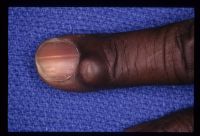
| Typical secondary
contour/ |
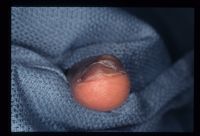
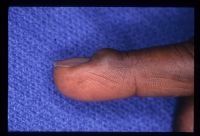
| These are usually
filled with clear colorless gelatinous material with
an appearance similar to mucous, but technically is
thickened synovial liquid, not mucous. The superficial
location allows the diagnosis to be confirmed with
transillumination. |


| Joint debridement is curative. Here, closure of the eponychial splitting incision is shown. |

| Late result with
restoration of normal eponychial and nail plate
contour. |

| Case 2. Nail deformity from subungual bone tumor. This patient has multiple hereditary exostoses. |




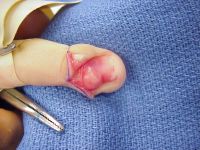




| Case 3. Another mucous cyst, more centrally located. Note both the nail deformity and the thin overlying skin. Repeated cyst drainage may lead to joint infection. |
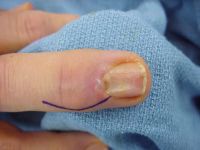



| Late result with
normalization of nail fold contour. |


| Case 4. Mucous cyst with contour abnormality and nail plate syrface irregularity. |


| Exposure. |

| Late result. |
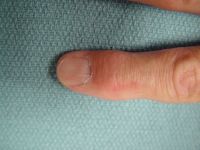
| Case 5. Distal phalanx osteochondroma. This painless unusual benign tumor resulted in a severe nail plate concavity. |





| Excision. |

| Restoration of
normal nail plate contour. |



|
Search for... fingernail deformity eponychial tumor
|
Case Examples Index Page | e-Hand home |